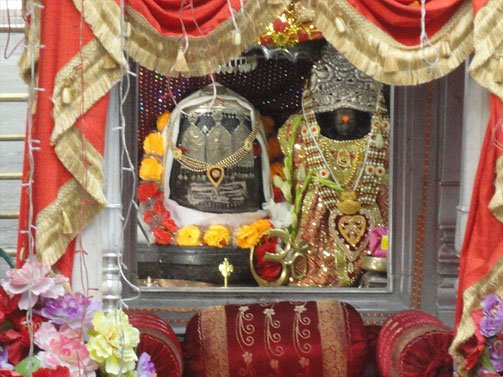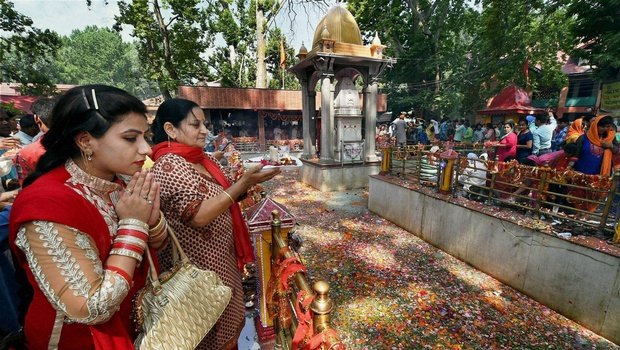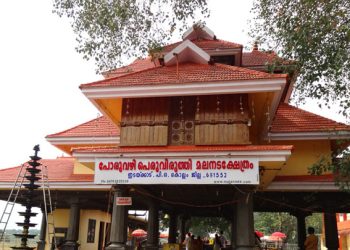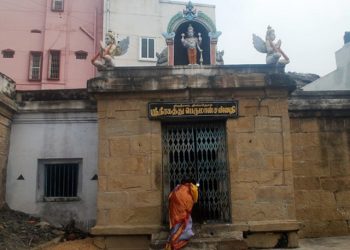Kheer Bhawani is a temple dedicated to the Goddess Kheer Bhawani (originally just Bhawani) constructed over a sacred spring. The worship of Kheer Bhawani is universal among the Hindus of Kashmir. The term kheer refers to rice pudding that is offered in the spring to propitiate the Goddess, which became part of the name of the temple. As is the custom with Hindu deities, she has many names: Maharagya Devi, Ragnya Devi, Rajni, Ragnya Bhagwati, and so on.
Shrine’s History
Maharagya was pleased with the devotion of Ravana and appeared before him and Ravana got an image of the Goddess installed in Sri Lanka. However, the Goddess became displeased with the vicious and licentious life of Ravana and so didn’t want to stay in Sri Lanka. Therefore, she is believed to have instructed Lord Hanuman to get the image from Sri Lanka and install it at the holy spot of Tul Mull.
Though Ragniya is a Rupa of Durga, this one is a Vaishnav Rupa in Kashmir Ragniya is also known as Tripura, while in (Sri) Lanka, the Mother Goddess was called Shayama. Sita too is believed to have been an incarnation of Ragniya. Ragniya Mahatmya has it that those who meditate on Panch Dashi Mantra during Nav-reh, Mother Ragniya grants their wish. It is said that the night during which Mother Goddess came from (Sri) Lanka to Kashmir was named Ragniya Ratri In Kashmir a number of shrines are dedicated to Mother Goddess at Tiker, Bhuvaneshvar, Manzgam (Noor-abad) Bheda, Lo-qraer-pur, Mani-gam, Rai-than and Baed-pur, but the Shrine at Tul-Mul is the most famous one and hence the focus of yatris. 360 springs (nagas) are said to have gathered there.
Ragniya is a Sattavie form of Mother Goddess, i.e. the form of tranquillity and bliss. The mention of Kheer Bhawani is found in Kalhana’s Rajtarangini. Kalhana writes that the sacred spring of Tula Mula is situated in a marshy ground. The name of the spring is Mata Ragini Kund (pond). Maharagini is the form of Durga Bhagvati. The brahmins of Kashmir worship this spring and pilgrims from every comer of the country visit to have the darshan of the place. In Rajtarangini, Tula Mula and the spring of Maharagya has been considered very sacred and the brahmins of Tula Mula considered notable for their spiritual prowess.
Thousands of years ago, many floods occurred in Kashmir and the sacred spring of Tula Mula was inundated under its sway and the holy place could nowhere be traced. At last, Kashmir’s Yogi Krishna Pandit had a dream in which the Goddess appeared to him and directed that she would swim in the form of a snake at the proper place and that he should stick large poles to demarcate the holy spot in the marshland. Subsequently, when the water subsided there the holy spot was discovered. This event happened during the Samvat 4041 (Hindu lunar date).



Shrine’s Map Location and How to Go There
By Road
The nearest Bus stop is Srinagar. Srinagar is well connected to Chandigarh (630 km), Jammu (290 km), Delhi (876 km), Leh (434 km) and Phalgam (96 km) by tourist bus services.
By Rail
The nearest railway station is Srinagar railway station or Nowgam railway station .The station, in nowgam, is 8 km from the city centre. Local services only: Qazigund?Anantnag?Srinagar?Baramulla.
By Air
The nearest domestic Airport is Srinagars new airport is connected with many airports of the major cities in India. Regular flights operate between Srinagar and Delhi, Mumbai, Chandigarh and the tickets are moderately priced. The nearest International Airport is Delhi International airport, which is at a distance of 876 km from Srinagar.


Shrine Timings
6.00 A.M – 8.00 P.M
Events Celebrated at This Shrine
Mela Kheer Bhawani – An Annual Festival: The devotees of the Goddess Mata Kheer Bhawani fast and gather here on the eighth day of the full moon in the month of May/ June.
Another festival, which is celebrated on a large scale in this temple is Shukla Paksha Ashtami. On this day, havans and yagnas are performed in the temple so as to please the goddess.
Extra Information About this Shrine
The marble temple was completed in the 1920s. Some people are of the opinion that there was a mulberry tree near the holy spot of Kheer Bhawani which, in a local language, is called Tul Mul. But Tul Mul is also derived from the Sanskrit word atulya mulya meaning great value. It is believed that Ravana, after his worship of the Goddess, offered her kheer (rice pudding), which she accepted and since then it is called Kheer Bhawani.













































